As educators, preparing our students for the future is one of our primary goals. With the rapid pace of technological advancement and the growing emphasis on skills like problem-solving, critical thinking, collaboration and innovation, integrating S.T.E.M into our elementary classrooms has never been more important. However, making STEM learning a regular part of our lessons can seem like a daunting task.
What is STEM?
It stands for Science, Technology, Engineering and Mathematics – the core subjects that drive our world’s advancement. In the classroom, STEM isn’t about memorizing facts but cultivating curiosity, collaboration and innovative thinking. STEM lessons engage students in asking questions, investigating solutions through experimentation and problem-solving, and applying their learning to real situations. A cohesive STEM approach recognizes how these disciplines interconnect and encourages logical, systems-level reasoning. While S.T.E.M may bring to mind advanced tools, elementary lessons often need only basic materials available in any classroom. The focus is nurturing students’ innate creativity and empowering them to tackle open-ended challenges through hands-on, active learning.
Getting Started with STEM
For teachers new to STEM, the key is starting small and gradually building experience over time. Some initial steps to ease into S.T.E.M include:
- Identify one lesson you already teach that lends itself to a STEM twist, such as measuring volumes in a math unit converting it into a challenge to design different containers. Begin with minor modifications to build confidence.
- Look for natural connections between your curriculum standards and STEM concepts. For example, teach properties of light in a science unit by having students construct simple circuits.
- Examine online resources for ideas from other teachers. Pinterest, Twitter and blogs provide a wealth of ready-made activities aligned with various grade levels and subjects.
- Focus first on process over product. Encourage students to view challenges as learning opportunities regardless of outcomes. Celebrate effort, teamwork and innovative thinking over right answers.
- Involve students in the planning process. Ask for their input on problems they would like to solve or skills they want to develop.
- Don’t worry about using specialized equipment or technology. Most S.T.E.M lessons require only common classroom supplies and everyday materials.
Most importantly, make it fun! If students associate it with games, hands-on exploration and creative design, they will be more motivated to learn.
STEM in Science

Science is a natural fit for STEM and offers countless opportunities for hands-on learning through experimentation and discovery. Some ideas to try include:
- Conduct simple investigations based on student-generated questions. Have them record observations and look for patterns in results.
- Grow plants from seed and challenge students to design the most efficient garden layout or irrigation system.
- Explore states of matter by having students engineer the tallest structure from marshmallows and toothpicks that won’t collapse under a given “earthquake.”
- Learn about sound waves by forming an “orchestra” with homemade instruments and experimenting with variables that affect pitch and volume.
- Study ecosystems through building a miniature habitat from natural materials found in the playground, then introduce “invasive species” to observe impacts.
- Discover properties of magnets by designing the most creative magnetic sculpture or a Rube Goldberg-style machine.
- Investigate forces and motion using ramps and toy vehicles. Have students test designs that can transport an “egg” safely or go fastest.
- Nurture an appreciation for the scientific process by keeping observation journals of class pets or outdoor plants/animals over time.
- Encourage an understanding of the engineering design cycle by tasking students with problems to solve, such as creating a better school snack or a device assisting with chores.
Promote STEM careers with guest speakers or virtual field trips to places like museums discussing science-related jobs.
S.T.E.M in Math
Mathematics integrates smoothly with STEM through hands-on applications of concepts. Try these ideas:
- Reinforce number sense by organizing a classroom store. Students can practice money skills like making change while roleplaying real-world math scenarios.
- Build math fact fluency into physical games like hopscotch or four square using multiplication flash cards as markers.
- Explore geometry through designing and constructing structures from basic materials according to provided blueprints focusing on specific shape properties.
- Promote algebraic thinking by posing word problems for students to model using drawings, diagrams and equations.
- Develop measurement skills in a baking unit where students must correctly measure ingredients for recipes.
- Learn about fractions through real-life tasks like sharing a pizza for lunch or dividing a plot of land for a garden.
- Practice data analysis on information gathered from citizen science projects or surveys students conduct in the community.
- Understand graphs and charts by tracking results of experiments or sporting events over time.
- Develop logical reasoning through board games that incorporate math operations and problem-solving.
- Apply mathematical modeling to design solutions for problems like building the most stable tower, strongest bridge or most fuel-efficient vehicle.
- Promote STEM careers by exploring how math is used in fields like architecture, engineering, coding and more with virtual tours or career days.
By grounding math practice in meaningful, hands-on contexts, students see the relevance and fun in what can otherwise feel like abstract exercises.
Read More: MyPLTW: STEM Curriculum Meets Career Readiness
STEM Beyond the Classroom
In addition to incorporating S.T.E.M into your daily lessons, consider these enrichment opportunities:
- Organize an engineering design challenge day where students work in teams to solve an open-ended problem through the engineering design process.
- Host a family STEM night with interactive booth showcasing class projects and simple at-home experiments for all to participate.
- Plan field trips to locations enriching your curriculum like parks conducting biodiversity research, museums with hands-on exhibits or local businesses employing STEM professionals.
- Partner with after-school programs or clubs to extend STEM exploration with activities like coding, robotics, rocketry or science fair mentoring.
- Participate in community initiatives applying classroom skills to real problems through activities like stream cleanups or citizen science monitoring programs.
- Connect with professionals through virtual guest speakers, job shadowing opportunities or partnerships where experts consult on classroom investigations.
- Participate in STEM competitions that enhance creativity, collaboration and presentation skills when sharing innovative solutions.
- Stock a makerspace area with materials inspiring tinkering like craft supplies, electronics, LittleBits or Osmo devices for open discovery time.
- Celebrate STEM learning with student-led showcases, science fairs or a blog to share ongoing projects with families.
By extending STEM beyond your walls, you deepen understanding and cultivate excitement about lifelong learning and careers in related fields.
Take Away
Incorporating STEM into your everyday lessons does not need to be an overwhelming endeavor. By starting small, focusing on process, and emphasizing creativity over final products, you can seamlessly weave STEM concepts into your existing curriculum. Tapping into students’ innate curiosity and problem-solving abilities through hands-on exploration of real-world issues will develop critical competencies and promote lifelong scientific thinkers. Whether through minor tweaks to current lessons, cross-curricular connections or special enrichment activities, the ideas presented here showcase just some of the many easy and practical ways to nurture STEM skills in your elementary classroom.




